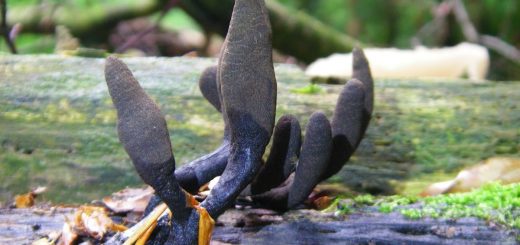#127: Ophidiomyces ophiodiicola, causal agent of Snake Fungal Disease
Snakes of the Eastern United States are dying of a disease called Snake Fungal Disease (SFD). Recently, the cause of SFD was identified as the fungus Ophidiomyces ophiodiicola. This fungus normally contributes to the decomposition of dead animals, but has for some reason been infecting live snakes since the early 2000’ SFD is primarily characterized by a severe rash on the snake’s skin, although it may also affect the snake’s eyes or even liver. The infection often results in death and in some species the mortality rate appears to be 100%.
Snake Fungal Disease is a dermatitis, meaning it primarily affects the skin. The exact set of symptoms associated with SFD varies from species to species. Most commonly, SFD is associated with crusty scales, scabs, abnormal or premature molting, clouding of the eyes, and the development of patches of thick or crusty scales. Some snake species often develop open wounds on the skin surface, facial swelling, and infection sites in their internal organs. Commonly affected organs include muscles, bones, lungs (pneumonia), and liver. The disease is often found on the snake’s head, but any part of the snake’s skin may become infected. SFD also results in unusual behavior, including anorexia, resting in exposed areas, and refusing food (due to facial swelling). Symptoms are usually most severe when snakes first emerge from hibernation. As snake activity increases, the disease symptoms often improve. SFD is a chronic disease, so it is likely that no snake ever fully recovers from the disease.
SFD is worrisome because it affects a variety of snake species. The disease is known to be found in at least 14 snake species belonging to at least six genera. Two of the species affected by SFD – the Timber Rattlesnake (Crotalus horridus) and the Eastern Massasauga (Sistrurus catenatus) – are considered endangered in multiple states. Mortality in these two species appears to be around 100% and infection with SFD has already caused localized population declines. Researchers are not sure exactly what is killing snakes in the wild. The disease itself could be the culprit, but secondary infections or increased predation due to behavioral changes may also help increase mortality.
Because snake populations are difficult to survey, it is hard to assess what impact SFD is having on broader snake populations. Difficulty in surveying snakes also hampers efforts to understand the spread of the disease. If SFD is found in a new state, it would be reasonable to assume that the infection had been present for a while but had not been reported. SFD has been confirmed in 15 states: it is present in Minnesota as well as in 14 states scattered around the area east of the Mississippi river.
The causal agent of SFD is the fungus Ophidiomyces ophiodiicola. This fungus belongs to the phylum Ascomycota, class Eurotiomycetes, order Onygenales, and family Onygenaceae. The primary role of O. ophiodiicola in the ecosystem is to decompose dead animal tissues, primarily keratin. Keratin is the protein which makes up snakeskin as well as human skin, hair, and nails. Despite this specialization, the fungus has been found growing on a variety of soil types, indicating that it can be found in almost any natural environment. O. ophiodiicola prefers growing in warm temperatures, so it is less virulent during the winter. Unfortunately, global climate change may raise average winter temperatures in some states. This could allow the fungus to grow uninhibited while snakes are hibernating. Consequently, snakes would emerge from hibernation with severe infections and mortality would greatly increase.
The origins and spread of O. ophiodiicola remain unknown, but it seems likely that the fungus is a widespread soil saprobe which recently acquired a mutation that allowed it to become pathogenic. Since O. ophiodiicola already breaks down keratin, it would not be difficult to make the switch from decomposing keratin in debris to doing the same thing in living tissues. The fact that the fungus can survive just fine without a living host makes it particularly worrisome for conservationists. The disease can likely be spread directly from snake to snake, but it may also be spread indirectly through the soil. In the latter case, an infected snake can distribute fungal spores wherever it goes. The spores then germinate, live in the soil, and infect any other susceptible snake that happens by. If this mode of transmission is at play, it would make eradication of the fungus impossible. Even if you could use antifungals to treat every infected snake (thus ending direct transmission), there is no way to remove the fungus from the soil (thereby perpetuating indirect transmission). Current research efforts are focused on learning more about O. ophiodiicola. At the moment, we do not know enough about the fungus to help snakes combat this pathogen.
Many researchers have noted that SFD shares many similarities to White-Nose Syndrome (WNS, FFF#026) in bats. Both are emerging fungal diseases, both are centered in Eastern North America, both began spreading in the early 2000’s, and both can grow saprobically on a wide variety of substrates. The two fungi are not closely related, but they do fill similar ecological niches. The timing of these two diseases is also significant. Snakes and bats face similar threats from humans, including habitat loss, pollution, and climate change. These factors can cause increased stress and may make animals more susceptible to emerging diseases. Since the fungi responsible for both SFD and WNS are present in the environment, they may not be completely new diseases. It is possible that these fungi periodically cause disease in their hosts. Scientific records do not extend far enough into the past for researchers to know for sure. Even if these diseases are not new, SFD and WNS clearly have the potential to drive some species to extinction.
Why should you care? Snakes are an important part of the ecosystem. Although most humans seem to have a distaste for the slithering reptiles, snakes are instrumental in keeping down populations of rodents, frogs, and other small animals. These include mice, which are primary sources of Lyme Disease. Snakes are also eaten by larger animals and birds of prey, thus connecting to many parts of the food web. Clearly, more research needs to be done if we want to preserve the diversity of Eastern North American snakes.
See Further:
https://www.nwhc.usgs.gov/disease_information/other_diseases/snake_fungal_disease.jsp
http://www.northeastparc.org/products/pdfs/NEPARC_SnakeFungalDiseaseFAQ.pdf
http://mbio.asm.org/content/6/6/e01534-15
https://news.illinois.edu/blog/view/6367/233712
http://www.sciencedaily.com/releases/2015/11/151117112047.htm
http://www.livescience.com/48723-snake-fungal-disease-update.html
http://eol.org/pages/39977309/hierarchy_entries/57321303/overview (taxonomy only)


![#070: Ganoderma applanatum, The Artist’s Conk [Archived]](https://www.fungusfactfriday.com/wp-content/themes/hueman/assets/front/img/thumb-medium-empty.png)





![#011: Characteristics of Kingdom Fungi [Archived]](https://www.fungusfactfriday.com/wp-content/themes/hueman/assets/front/img/thumb-small-empty.png)



2 Responses
[…] Fungal Disease (SFD, FFF#127) was detected in Wisconsin and Minnesota, suggesting the disease continues to move westward across […]
[…] fungal disease (SFD, FFF#127) – a disease caused by the fungus Ophidiomyces ophiodiicola and threatening many snake species in […]